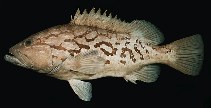| Family: |
Epinephelidae (Groupers) |
| Max. size: |
66 cm SL (male/unsexed) |
| Environment: |
demersal; marine; depth range 120 - 250 m |
| Distribution: |
Eastern Central Pacific: known only from the French Polynesia, Pitcairn Group, and Rapa. |
| Diagnosis: |
Dorsal spines (total): 11-11; Dorsal soft rays (total): 15-15; Anal spines: 3-3; Anal soft rays: 8-8. Distinguished by the following characteristics: pale yellowish brown body color; irregular coarse reticulum of dark brown on body and rear part of head; fins unmarked; body depth contained 2.7-2.9 times in SL; head length 2.2-2.4 times in SL; convex interorbital area; subangular preopercle, 3-4 distinctly enlarged serrae at the angle; straight or nearly straight upper edge of operculum; anterior nostrils smaller than posterior nostrils; maxilla reaches almost to or slightly past vertical at rear edge of eye; 2 rows of teeth on midlateral part of lower jaw, inner teeth larger; well developed canine teeth at front of jaws (Ref. 89707). |
| Biology: |
Inhabits the outer slope of coral reefs. Fourmanoir (1971, Ref. 6828) found ophichthid eels, Leiuranus phoenixensis, in the stomachs of his type specimens. May be of some importance to artisanal fisheries and it is rarely caught because of its preference for deep water. |
| IUCN Red List Status: |
Least Concern (LC); Date assessed: 22 November 2016 Ref. (130435)
|
| Threat to humans: |
harmless |
| Country info: |
|
Source and more info: www.fishbase.org. For personal, classroom, and other internal use only. Not for publication.

